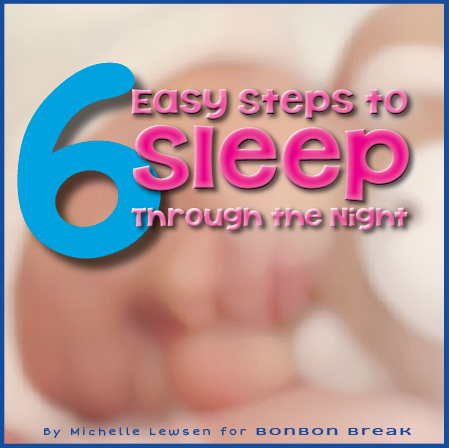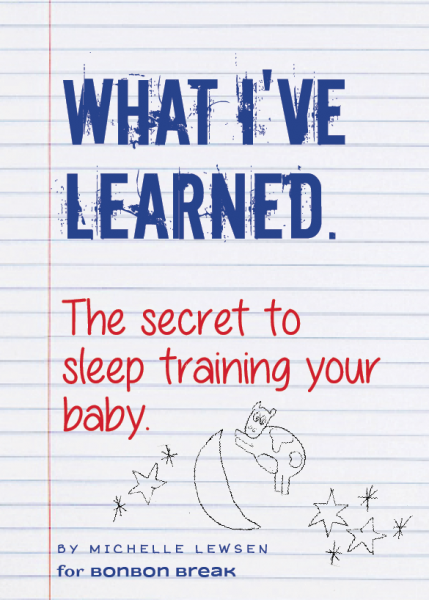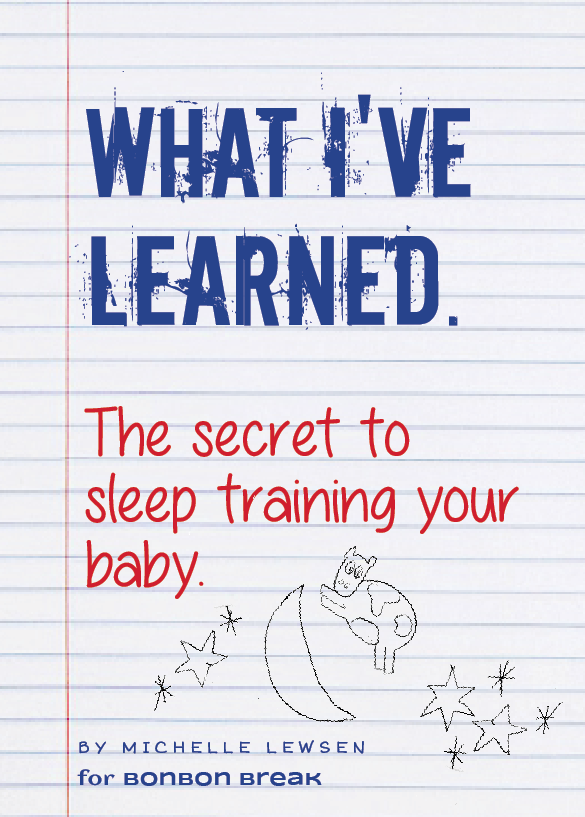What I’ve Learned: 6 Easy Steps to Sleep Through the Night

I want you to imagine two scenarios:
Scenario 1: You’re with someone you adore, having a lovely time. You’re warm and happy and you feel safe. Then that person takes you and puts you into a pit of vipers, looks at you with fear in her eyes, begs you to please not cry then quickly walks out and expects you to relax and go to sleep. Would calmly drift off to sleep or would you scream bloody murder until you were rescued? Well, duh.
Scenario 2: You fall asleep happily in the arms of your loved one and when you wake up, she has disappeared, you’re all alone and who-knows-what might happen to you and issheevercomingback? You’d scream like a banshee, right? I would.
These are the two options many parents are offering their babies when it’s time to go to sleep. Both are equally traumatic for the baby and the parent and, in my experience, neither of them works particularly well.
What if I told you there’s a third option?
When Miss M was 6 months old, I learned about a sleep-training philosophy based on understanding my baby and communicating with her. This method taught my baby to sleep soundly, deeply and independently. And it worked almost immediately. By immediately, I mean she slept from 7pm to 7am on day one and never regressed.
The basic premise is so simple and such common sense. It’s a philosophy that’s shaped much of my parenting because it is all about communication. As parents, we are so scared of bedtime, we are so afraid of our babies screaming and waking up all night. So what do we do? We transmit this fear to our babies. Our faces express our worry. Our myriad of crutches (patting, rocking, hypnotising) broadcast the message that this is indeed a hard thing to do – so much so that all these things need to be in place before sleep can be achieved. We tiptoe out of their rooms when they finally fall asleep – reinforcing their fear that we can’t be trusted to be there when they wake up. Obviously, they are going to scream. How can we possibly expect them to relax in this kind of environment?
1. Remove the fear.
This means telling yourself that bedtime is not scary, hard or terrible. You look forward to your sleep and why shouldn’t your baby. If your face is full of fear, your baby will be scared. If you’re relaxed and happy, your baby will be too. Quite simple really.
2. Create a positive, flexible and simple bedtime routine.
We always bathed our kids before bed, then read a story, had a cuddle and a song before bed. When they were babies, we would take them around the room and say “goodnight” to the animal pictures on the walls, the teddies and so on. This was a great part of the routine because it reinforced “goodnight” and best of all – it is portable! Meaning, when you need to put your little one to sleep at grandma’s house, you can say goodnight to her things too. You’re not tied down to a specific room.
3. Show your baby that you aren’t stressed.
After the “goodnights”, I’d put the Miss M in her cot, smile and look her in the eyes (showing that I was happy and relaxed about this situation) and cheerfully say “Night night! Good girl! I’ll be right back.” and walk out.
Of course, the first time I did this, Miss M went hooligan on me. It was her morning nap and she screamed like a lead soprano in the world’s loudest opera. Hubby and I stood outside her room and wanted to cry. Andrea Bogue, Baby Whisperer extraordinaire, explained that we needed to teach Miss M that when she doesn’t cry, that’s when we come back, that being still and relaxed would bring us back.
In essence, reward the behaviour we want to see.
After a minute of two, when the crying started to wane, one of us would go back in, smile and say again “Good girl! You’re not crying! I’m coming back again.” And out we went. Amazingly, it took very little time for her to realise that being quiet and relaxed brought us back in. Not only did we come in without her having to yell for us, but we were smiling and not scared. Hmmmm – she started to realise that sleeping might not be so hard and scary after all.
Once she was quiet for an extended period of time, we started to whisper that OMIGOSH SHE IS QUIET! We were instructed not to whisper. Instead, we walked in and in happy, conversational voices we repeated the mantra that she was a good girl, not crying, going to sleep so nicely. To our complete shock, she was still awake. Just lying there, quietly. Our baby. She looked at us, smiled, closed her eyes and went to sleep. After a few minutes we went in again, found her asleep and again repeated the mantra. And again 3 minutes later. For the first time ever, Miss M napped for two straight hours. She woke up cooing, not crying. It was like we had a different child.
We repeated the process for her midday nap with faster results and by the first night, she was asleep in about 30 minutes. And she slept for 12 hours.
4. It’s all about rewarding the behaviour we want to see.
As parents, we are hard-wired to rescue our children when they are crying. So, it’s only natural that we run in to their rooms when they cry at night. The difference between this and other situations is that, in their cribs, our babies are not hurt or in danger. They are crying because they want us there. By teaching them that we are going to be popping in to their room to check-in when they don’t cry, we eliminate that fear and we create a situation where they can completely relax and fall into a deep sleep, safe in the knowledge that they haven’t been abandoned. By showing them that bedtime is a happy, relaxing time of day, we create an environment that they want to be in. If we give them no reason to cry, they don’t cry. Simple, really.
This is the exact opposite of classic the Cry It Out technique.
Start by making it clear to your baby that sleep time is a lovely thing. Say goodnight with a smile and reassurance that you’ll be back. Be prepared for the yelling and screaming and wait for the cries to subside (no longer than a minute or two – in the beginning, you may need to grab the breathless moment between cries to illustrate what you want). As soon as there’s a break in the crying, go in and praise the good behaviour, tell her you’ll be back and then walk out. Even if your baby doesn’t understand your words, she will understand the tone. Repeat this process and you’ll notice that your baby will begin to have longer non-crying periods. Praise each and every one.
5. Your baby is smarter than you think.
I can assure you, your baby can read your expressions. Show her that you’re relaxed and she will relax. Sow her that she doesn’t need to scream to have to you check-in on her and she will stop screaming. Check-in loudly and confidently, even once she’s asleep and she won’t feel the need to yell for you when she wakes in the night. If she falls asleep experiencing the comfort of you popping in and out, she will wake in the night, assume you’re coming soon, and go back to sleep. Obvious, right?
6. It works on big kids, too.
When it was time to move Miss M into her big girl bed, we panicked. How was this going to turn out? How would we get her to stay there? Again, we called on our sleep angel.
Turns out, the same philosophy applies to big kids. On the first night, we did her same routine, then stood in her room and said “I’m going out and when you’re on your bed, I’ll be back.” Giggles ensued and after a few seconds I returned and found her on the bed. Then. “Okay – I’m going out again and when you’re under the covers, I’ll be back for a story” Ahhh – it’s a cool game! More giggles, and when I walked back in, she was under her covers. I jumped in, read her a book and kissed her goodnight.” Then, “night night, Missy, when you have your head on the pillow I’ll be back with a giant Wiggly snuggle” (she was into the Wiggles, so this was the currency – it could just as easily be an Elmo tickle or a Little Mermaid kiss). More chuckling and a minute later, there she was with her head on the pillow. Last request, “when I your eyes are closed and you’re on your way to dreamland, I’ll be back with another Wiggly snuggle”. A few minutes later, she was asleep, smiling and dreaming of fruit salad, yummy yummy. It really was this easy.
Why did this work?
Because she was in control. I wasn’t saying “if you do this, you get…”, implying that I desperately wanted her to comply. I was saying “when you do this, the next fun thing is coming”, creating a situation where she was going to bed because she wanted to. No power struggle, just a fun and happy bedtime for all.
This has worked for all three of my children. It has worked for the countless friends I have helped through their children’s sleep issues. It’s a positive and non-stressful method to get babies and kids to sleep deeply and through the night.
Everyone wins because well-rested mummies are less prone to hysterical meltdowns (in the middle of the supermarket, a story for another day) and well-rested babies are happier, more switched on to learning and developing. They are also calmer babies because their mums aren’t falling to pieces.
I am no baby sleep expert. I’m just a mum who knows what sleep-deprivation feels like and has seen the light at the end of the tunnel. Can you see it? I promise, it’s there.
Sweet dreams!
Disclaimer: This is in no way medical or professional advice. Please feel free to contact Andrea Bogue, my Baby Whisperer for personalised advice on +61 411 130 498 (Australia). This post represents Michelle Lewsen’s personal opinion and experience based on her own children and was not paid for or sponsored in any way.
Read more from Michelle on BonBon Break
This post was written by Michelle Lewsen exclusively for BonBon Break Media, LLC
Pin it for Later



